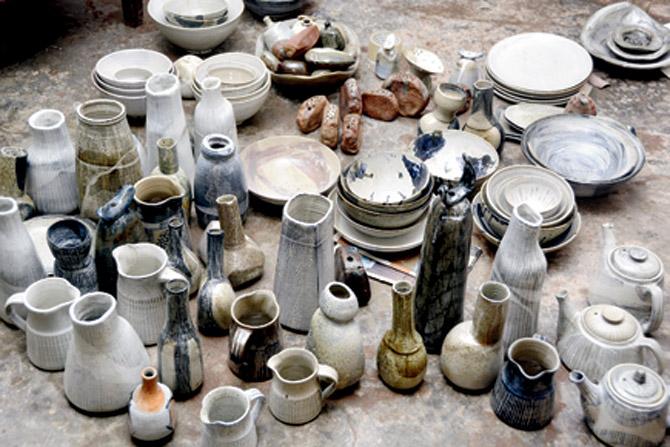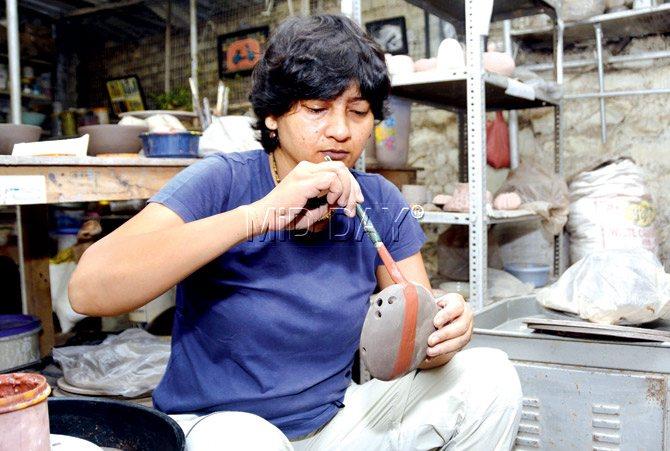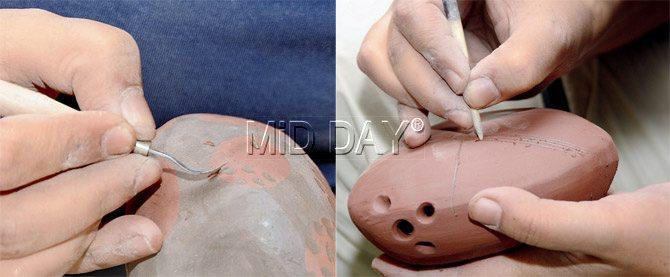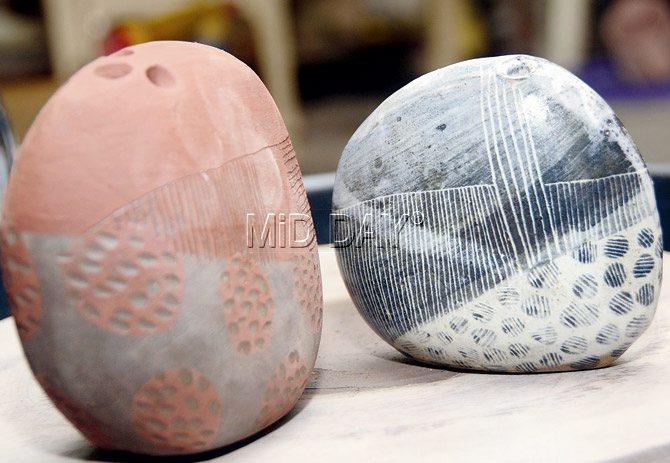This weekend, check out clayware with fossil-like designs made using an old Italian technique


The collection features 250 pieces
A cat and its three restless kittens jump over a kneading table, walk through clay sacks, try to snuggle in wide bowls and sneak under a brick-and-metal box kiln as ceramist Devyani Smith, undisturbed, continues throwing (process of shaping a pot on a potter's wheel) at her pottery studio in Goregaon.
ADVERTISEMENT
Seated on a low stool in a garage-like space, wedged between fibre-casting workshops, she uses a carving tool to fine-tune the shape of a bowl, which swirls on an electric pottery wheel, the only machine in the studio.

Devyani Smith applies a coat of slip on a clay vase at her studio in Goregaon
The floor beside her is populated with over 50 finished clayware products — mugs, jars, vases, plates and bowls — in earthy browns, greys, olive green and indigo, pinched by hand or beaten on a table to create asymmetrical shapes. These are part of her collection, Aether, to be showcased at ARTISANS' this weekend. The exhibit-cum-sale, priced '850 onwards, marks the Ludhiana-born, Shimla-bred and Mumbai-based artist's first solo.
Know the sgraffito
In sync with the volatile fifth element that the collection is christened for, the pieces feature fossil-like illustrations, derived using Smith's signature sgraffito (Italian: to scratch) technique, where a preliminary surface is covered with another, and then scratched with a superficial pattern to reveal the lower colour.

She uses a porcupine quill (right) and a hook-edged chisel for the sgraffito effect. Pics/Sneha Kharabe
First used in panel paintings in Europe during the Middle Ages, sgraffito ware is said to have been produced as early as 1735 by German settlers in colonial America. "Though I was good at craft since childhood, my brush strokes were bad. So, when I took to pottery (in 2008), I would paint a piece and scratch parts of it to create designs. Later, I realised that the technique actually has a name," says Smith, an ex-media professional, who worked with various production houses in Delhi for over eight years, before taking
to pottery.
She took basic lessons in wheel-thrown pottery from Hanif Galwani in his Dharavi studio, which is also a neighbourhood from where she sources her clay. At her studio, she also teaches those interested in pottery. "It takes three months to get the pottery basics right," says the artist, who stocks her products at Bungalow 8.

The look of the vase before (left) and after itâu00c2u0080u00c2u0088is glazed and fired in a kiln
Oh, slip!
To show us an instance of the sgraffito technique, Smith picks up a pinched pebble-shaped dried vase. On half of the piece, she applies a coat of slip — a red liquid comprising powdered clay, colouring oxide and water — using a paintbrush. On the other half, she paints large, oblong spots and lets them dry.
Then, using a porcupine quill, she begins to draw lines in the painted half and scratches out tiny spots with a hook-edged chisel on the other side. "Now, I will load it in a kiln (that she built herself) at 850 degrees Celsius for over seven-eight hours. Once it cools, I will glaze it and re-fire it for over 10 hours at 1220 degreeâu00c2u0080u00c2u0088Celsius. The whole process takes about 10 days. Then, it will look like this," she points at a similar-shaped olive green vase with thin, white stripes and a silky smooth texture.
According to Smith, the green colour was derived from a mud brown slip, which looks similar to clay. "I use a variety of colouring oxides to create different-coloured slips, but I don't like glossy, bright colours. It's trial-and-error. By now, I know the colour bracket that I will get when I make slip, but it's still a shade off from the previous batch because I don't really note down what I do," says Smith matter-of-factly, as she heads to watch over a student trying the technique on a plate.
 Subscribe today by clicking the link and stay updated with the latest news!" Click here!
Subscribe today by clicking the link and stay updated with the latest news!" Click here!







